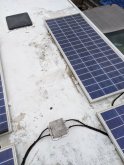pat.kane
New Member
I have a new-to-me 2009 Freightliner step van that spent its previous life as a LDV-made tool truck. I'm still building basic knowledge and trying to understand what I have before I get on the road full time in a little over a year.
On the roof are four, factory-installed Go Power! GS RV 110 solar panels. The panels are rated 110W, 6.7A and 16.4V. I checked voltage at noon today (sunny and no shade) in Washington, DC, area and the voltage was ~18V and current was ~4A. Wouldn't the voltage output suggest the panels are wired in parallel, and if so shouldn't the amps be much higher?
I cracked open the combiner box on the roof last weekend and given what I see it would appear the panels are 2S2P instead of 4P, so the above output does makes sense to me. I know how to use a multi-meter and the one I am using is rated to measure DC current up to 400A, but I guess it could be a dud, or I'm just not understanding winter sun angles, etc.
The rest of the house battery system is:
Inteli-Power PD2160 Electronic Marine Converter/Charger (rarely will I be plugged in)
Cole Hersee Co. No. 48161 Schottky Battery Isolator Guard 250A 12-24V DC (step van alternator is assumed to be 200A+)
Morningstar ProStar-30 (PS-30) PWM Solar Charge Controller
Two 6V SBS S-6V225GC batteries (was four but two were dead and these don't have much life left)
I plan to put ~600W more of solar on the roof and move to LiFePO4 in the future.
On the roof are four, factory-installed Go Power! GS RV 110 solar panels. The panels are rated 110W, 6.7A and 16.4V. I checked voltage at noon today (sunny and no shade) in Washington, DC, area and the voltage was ~18V and current was ~4A. Wouldn't the voltage output suggest the panels are wired in parallel, and if so shouldn't the amps be much higher?
I cracked open the combiner box on the roof last weekend and given what I see it would appear the panels are 2S2P instead of 4P, so the above output does makes sense to me. I know how to use a multi-meter and the one I am using is rated to measure DC current up to 400A, but I guess it could be a dud, or I'm just not understanding winter sun angles, etc.
The rest of the house battery system is:
Inteli-Power PD2160 Electronic Marine Converter/Charger (rarely will I be plugged in)
Cole Hersee Co. No. 48161 Schottky Battery Isolator Guard 250A 12-24V DC (step van alternator is assumed to be 200A+)
Morningstar ProStar-30 (PS-30) PWM Solar Charge Controller
Two 6V SBS S-6V225GC batteries (was four but two were dead and these don't have much life left)
I plan to put ~600W more of solar on the roof and move to LiFePO4 in the future.




